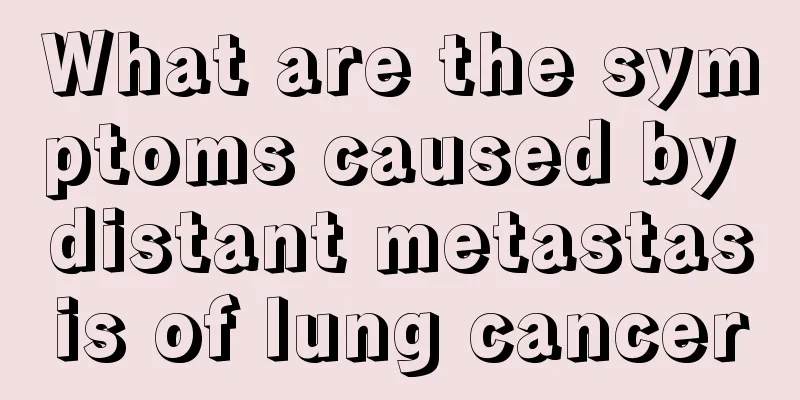Clinical manifestations of renal cancer

|
Hematuria, pain and tumors are called the "triad" of kidney cancer. Most patients have 1-2 symptoms when they seek medical treatment, and only about 10% have all three symptoms. Kidney cancer may have already metastasized to distant sites when there are clear clinical symptoms, with lung and bone metastases being the most common. In some cases, metastatic lesions are first discovered, and kidney cancer is only diagnosed when the primary tumor is traced back. 1. Hematuria Hematuria caused by renal cancer is often intermittent, painless, and visible throughout the entire process. There may be no visible hematuria during the intermittent period, but there is still microscopic hematuria. The intermittent period of hematuria shortens with the course of the disease, and severe hematuria may be accompanied by renal colic. The degree of hematuria has nothing to do with the size of renal cancer, and some cases only present with persistent microscopic hematuria. 2. Low back pain It is a common symptom of kidney cancer, most of which is dull pain, caused by the tumor growth involving the renal capsule. When the tumor invades surrounding organs and lumbar muscles, the pain is severe and continuous. Bleeding in the tumor or blood clots through the ureter can cause severe low back pain and abdominal pain. 3. Tumor Waist and abdominal swelling is also a common symptom of kidney cancer. One-third to one-quarter of kidney cancer patients can be found with enlarged kidneys when they seek medical treatment. The kidneys are hidden and tumors must reach a certain size before they can be found. The surface is smooth, hard, and painless. It moves with breathing. If the tumor is fixed, it may have invaded nearby organs. 4. Fever About 1/3 of patients have systemic symptoms, with fever being the most common. Some scholars have advocated that fever, hematuria, pain and tumors be called the "quadruple sign" of renal cancer. Most patients have low-grade fever, which persists and occurs intermittently. Some patients have been diagnosed with renal cancer due to high fever. 5. Hypertension 20%-40% of patients with renal cancer develop hypertension due to compression of blood vessels by the tumor, arteriovenous fistulas within the tumor, and increased production of renin by the tumor tissue, which needs to be distinguished from primary hypertension. 6. Red blood cell changes Renal cortex of patients with renal cancer is hypoxic, which releases erythropoietin to regulate red blood cell production and differentiation. Therefore, 3%-10% of patients with renal cancer have elevated erythropoietin in their blood. However, anemia is more common in patients with renal cancer. The main reason is that there are fewer normal red blood cells and normochromic red blood cells, and the serum iron or total iron binding capacity of microcytic and hypochromic red blood cells is reduced, which is similar to anemia caused by chronic diseases. Iron therapy has no effect. Resection of renal cancer can restore red blood cells to normal. 7. Immune system changes Renal cancer may be accompanied by neuropathy, myopathy, amyloidosis, and vasculitis. Like other tumors, renal cancer may cause neuromuscular lesions, and there are reports of renal cancer complicated by bilateral diaphragmatic paralysis. Recently, there have been reports of cases of renal cancer with vasculitis, which is considered to be one of the paraneoplastic syndromes or paraneoplastic syndromes. 8. Renal cancer metastasis with clinical symptoms For example, spinal metastasis may cause low back pain, spinal cord compression causing lower limb movement disorders, and incontinence. In addition, renal cancer is accompanied by extra-renal symptoms such as increased renin levels, hypercalcemia, increased prostaglandin A, human chorionic gonadotropin, increased urinary polyamines, increased blood carcinoembryonic antigen, varicocele, etc. |
<<: Pathological types of gastric cancer
>>: The cause and pathogenesis of lymphoma
Recommend
How to make delicious chicken soup
Drinking soup is a habit of many people. Nowadays...
What to do if you are stupid
Some people often feel that their brains are dull...
What harm does breast cancer do to the body
Breast cancer is a very common disease in the bre...
Stomach pain and diarrhea
You can't get sick no matter what. Although t...
How to relieve orthodontic pain
Some people will feel extreme pain after having t...
How to transplant hair?
Severe hair loss and sparse hair will actually af...
What should I do if I find out that I added too much alkali after the rice dumplings are cooked?
Zongzi is a must-have for our traditional festiva...
How to remove ink from clothes
When we accidentally spill ink on our bodies, it ...
How often should the hepatitis B vaccine be given? Inject on time
Children nowadays have been vaccinated since the ...
Can I have a medical abortion at 50 days of pregnancy?
If you need an abortion when you are 50 days preg...
How to prevent and treat small cell lung cancer
How to prevent and treat small cell lung cancer? ...
Heart failure caused by too rapid infusion
Normally when we are receiving an infusion in the...
What should I do if my fingers become numb due to cervical spondylosis?
In modern society, science and technology are dev...
What's going on when transparent dots appear on the fingertips?
There are many densely packed transparent bubbles...
How to care for patients with laryngeal cancer who are living with tubes after surgery?
Surgery is the main treatment for laryngeal cance...









